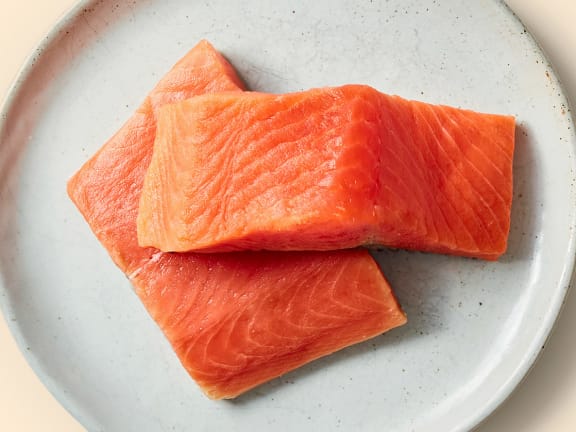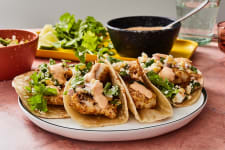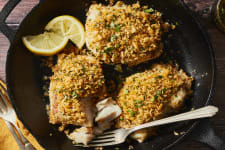Almost anyone with a dog knows the challenges of finding pet food with a protein that your pup can handle without getting allergies or digestive issues. Chicken is a popular animal protein option, as are lamb and beef. But what about seafood? You love to eat wild-caught salmon from Alaska — can your dog eat it, too?
Can dogs eat salmon?
Yes, generally, dogs can safely eat salmon. In fact, in Alaska, working sled dogs were traditionally fed a diet rich in salmon.
Commercially, salmon is a primary protein used in kibbles and dried treats. Cooked salmon meat is a popular nutritional addition to a dog’s diet. Serve it as a topper or a treat, or use it in homemade dog food.
Nutritional Value of Salmon for Dogs
Like humans, dogs benefit from wild salmon’s high-quality protein, omega-3 fatty acids, vitamins such as D and B, and minerals (such as selenium and potassium). These can help keep your dog’s coat lustrous, skin itch-free, and brains working well.
Omega-3 fatty acids are also a boon for dogs with arthritis and other inflammatory conditions. For context, 6 ounces of coho salmon contains nearly half a human’s recommended daily intake of omega-3 fatty acids. That’s a lot of omega-3s.
More scores for salmon? It’s low in mercury and highly digestible. Many dogs with sensitive stomachs thrive on high-quality dog food made with salmon and benefit from supplementation.
Safety Concerns and Considerations
Salmon is a nutritional powerhouse, but that doesn’t mean you should regularly offer your dog whole filets. For one, dogs should eat cooked salmon rather than raw because raw salmon might have harmful pathogens that can make them sick. Salmon poisoning disease is a potentially fatal bacterial infection in dogs that occurs when they eat certain types of fish infected with a particular pathogen.
Take care to remove any bones. Dogs can easily choke or hurt their teeth and gums on salmon bones, plus bones can get lodged in your furry friend’s throat or digestive tract. You do not want to deal with a dog with a gastrointestinal blockage. And dogs should eat unseasoned salmon free of sauces and spices that might harm their health. No offering up a garlicky stir fry, please.
Can dogs eat salmon skin?
If you don’t like salmon skin, you’re in luck: feeding dogs cooked salmon skin in moderation is generally safe. All the same precautions as above apply: remove any bones, ensure the skin is thoroughly cooked, and avoid seasonings and spices. Because salmon skin is relatively high in fat, give it sparingly to prevent digestive issues and help your dog maintain a healthy weight.
Can dogs eat smoked salmon?
While your dog would probably love to swallow an everything bagel with lox, cream cheese, and capers, smoked and cured salmon is high in salt. Too much salt in a dog’s diet can lead to sodium toxicosis. On a rare occasion, a tiny piece of cold smoked sockeye won’t hurt them, but you’re better off sticking to cooked and unseasoned salmon.
Feeding Guidelines
If you want to supplement your dog’s diet with cooked salmon, consult your vet about portion sizes for your specific pet; a larger or more active breed can safely eat much more salmon than a smaller or sedentary breed.
If you make your dog food and want to include salmon, again, consult with your vet to ensure your homemade mixture satisfies your dog’s complex nutritional needs.
With dogs that have never enjoyed salmon before, start by offering them a little salmon as a snack or treat so their stomach can adjust to the new food, and monitor for signs of allergies like itching, vomiting, and diarrhea.
Quality Control
Be sure to feed your dog sustainably caught salmon by sourcing your seafood online from Wild Alaskan Company. You’ll get high-quality, wild-caught salmon delivered straight to your doorstep. Choose your salmon subscription box today.






